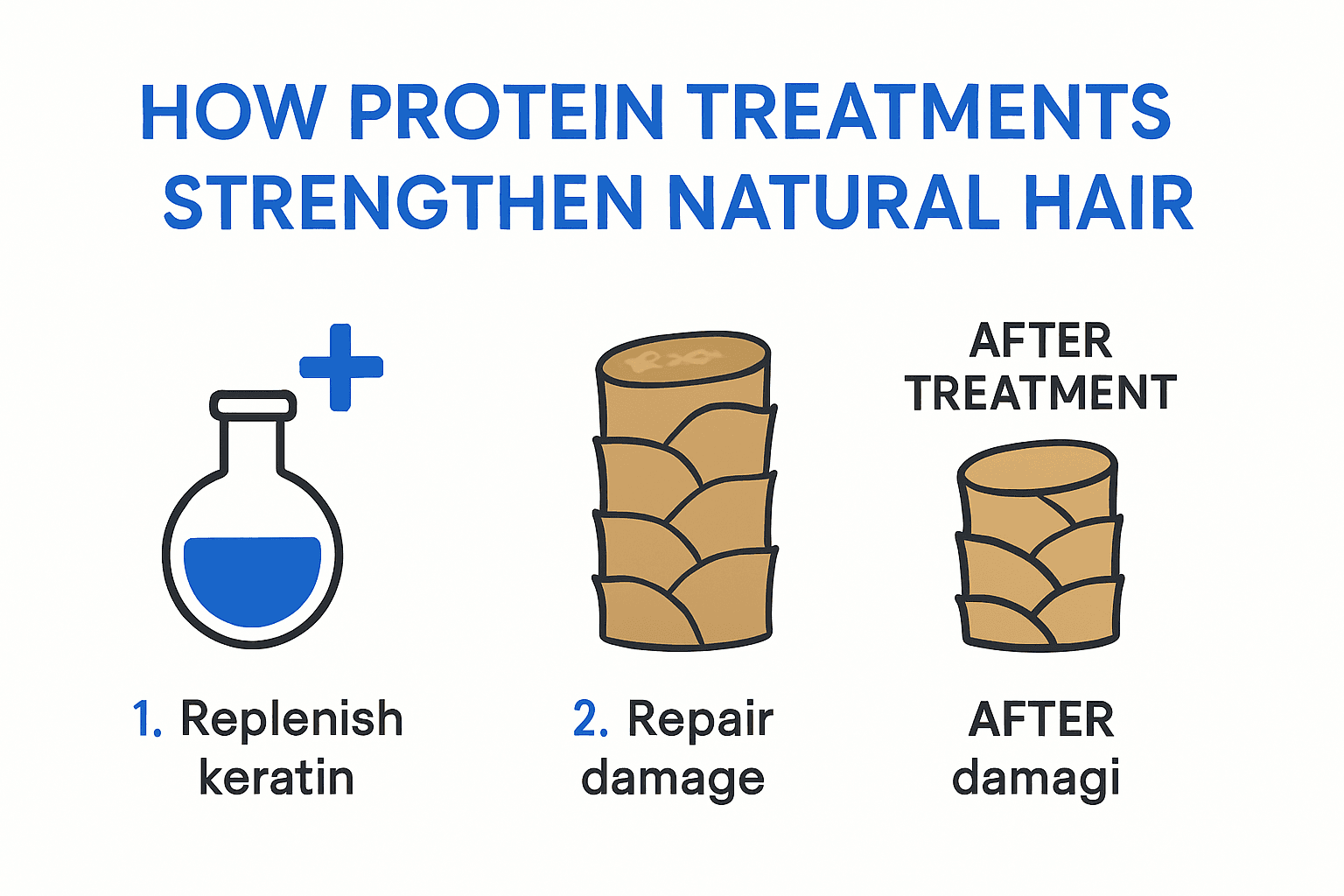Blog
Learning Materials
Best Protein Treatment for Natural Hair in 2025: Growth & Care

Tilen
Updated: July 6, 2025

Protein treatments are making waves in the world of natural hair, promising stronger strands and real growth for everyone searching for healthier locks. Here is something that changes the conversation. Scientific research shows that consistent protein treatments can reduce hair breakage by up to 50 percent and actually increase hair diameter. Many think slathering on any hair mask will do the trick, but the real results happen when you match the right protein treatment to your hair’s actual needs, opening the door to healthier, longer, and fuller hair than most expect.
Table of Contents
- What Is Protein Treatment For Natural Hair
- How Protein Treatments Help With Hair Loss
- Tracking Hair Growth After Protein Treatment
- Choosing The Right Protein Treatment For You
Quick Summary
| Takeaway | Explanation |
|---|---|
| Understanding Protein Treatments | Protein treatments are essential for strengthening and revitalizing natural hair by replenishing its core structural components, helping to restore protein balance and enhance hair health. |
| Tailoring Treatment to Hair Needs | Selecting the right protein treatment involves assessing your hair's texture, damage level, porosity, and breakage frequency to find the most suitable option for your specific needs. |
| Importance of Consistency | Consistent protein treatments can reduce hair breakage and improve overall resilience, making regular application key for maintaining healthy hair. |
| Tracking Growth Metrics | To effectively measure the impact of protein treatments, individuals should track hair growth metrics like length, thickness, and follicle density using systematic and advanced monitoring techniques. |
| Holistic Approach to Hair Health | A holistic approach incorporating nutritional interventions and a personalized strategy can significantly enhance the effects of protein treatments, addressing underlying issues contributing to hair loss and damage. |
What Is Protein Treatment for Natural Hair
Protein treatments represent a specialized hair care approach designed to strengthen and revitalize natural hair by replenishing its core structural components. These targeted treatments work at the molecular level to address hair damage, restore protein balance, and enhance overall hair health.
Understanding Hair Protein Structure
Natural hair is fundamentally composed of keratin, a complex protein that provides strength, elasticity, and resilience. Research from the National Institutes of Health reveals that repeated chemical processing, heat styling, and environmental stressors can significantly deplete hair's natural protein content. When hair loses protein, it becomes weak, brittle, and prone to breakage.
Protein treatments strategically infuse hydrolyzed proteins into the hair shaft, creating a reinforcement mechanism that rebuilds and strengthens hair from within. These treatments typically contain small protein molecules that can penetrate the hair cuticle, delivering targeted reconstruction where damage is most pronounced.

Types of Protein Treatments
Natural hair protein treatments come in various formulations, each designed to address specific hair concerns. Some key varieties include:
- Keratin Treatments: Deep protein reconstructors that smooth and strengthen hair
- Hydrolyzed Protein Treatments: Lightweight options that provide subtle protein reinforcement
- Amino Acid Treatments: Molecular-level repairs targeting specific protein deficiencies
The effectiveness of these treatments depends on understanding your hair's unique protein-moisture balance. Scientific studies from dermatological research indicate that over-proteinating can lead to hair becoming rigid and more susceptible to breakage, emphasizing the importance of precision in application.
To help clarify the different types of protein treatments and their key features, see the table below.
| Treatment Type | Key Benefits | Ideal For |
|---|---|---|
| Keratin Treatments | Deep reconstruction, smoothing | Severely damaged hair |
| Hydrolyzed Protein Treatments | Subtle reinforcement, lightweight | Regular maintenance, fine hair |
| Amino Acid Treatments | Molecular repair, targets deficiencies | Specific protein deficiencies |
Professional Insights and Application
Professional hair care experts recommend protein treatments as a strategic intervention for natural hair experiencing significant damage. According to trichology research, consistent protein treatments can reduce hair breakage by up to 50% and improve overall hair resilience.
To maximize benefits, learn more about personalized hair care strategies, users should consider their individual hair texture, damage level, and specific hair health goals when selecting and applying protein treatments. The key is finding a balanced approach that restores protein without compromising hair's natural moisture and flexibility.
Whether you have chemically treated hair, experience frequent breakage, or simply want to maintain optimal hair health, protein treatments offer a scientifically backed solution for nurturing and protecting your natural hair's fundamental structure.

How Protein Treatments Help with Hair Loss
Protein treatments emerge as a critical strategy in addressing hair loss, offering a scientifically supported approach to strengthening and revitalizing hair follicles. These specialized interventions target the fundamental root causes of hair weakening and potential loss, providing a proactive solution for individuals experiencing thinning or fragile hair.
Protein's Role in Hair Follicle Restoration
Research published in the Journal of Cosmetic Dermatology demonstrates that protein supplementation can significantly enhance hair growth mechanisms. The study revealed that marine protein supplements increased terminal and vellus hair growth, expanded hair diameter, and reduced overall hair loss in both men and women.
Hydrolyzed proteins play a crucial role in this restoration process. Scientific investigations indicate these proteins penetrate the hair shaft, neutralizing negative electrical charges and creating a protective surface coating. This mechanism not only strengthens individual hair strands but also creates an environment conducive to healthier hair growth.
Nutritional Interventions and Hair Loss Prevention
Certain amino acids have shown remarkable potential in combating hair loss. Comprehensive medical research highlighted the effectiveness of specific amino acids like L-cystine and L-lysine in normalizing hair growth rates. These nutrients work at the cellular level to support the anagen (growth) phase of hair follicles, potentially reversing patterns of hair thinning.
Key amino acids contribute to hair health through multiple mechanisms:
- Structural Reinforcement: Provide building blocks for keratin production
- Cellular Nutrition: Support metabolic processes in hair follicles
- Oxidative Stress Reduction: Protect hair roots from environmental damage
Below is a table summarizing the roles of specific amino acids in hair health as discussed above.
| Amino Acid | Main Role in Hair Health | Mechanism |
|---|---|---|
| L-cystine | Supports keratin production | Structural reinforcement |
| L-lysine | Promotes hair growth phase (anagen) | Cellular nutrition |
| (General) | Protects hair roots | Oxidative stress reduction |
Holistic Approach to Hair Loss Management
Protein treatments represent more than a surface-level solution. Check out our comprehensive guide on hair restoration strategies to understand the intricate relationship between nutrition, hair structure, and growth potential. By addressing protein deficiencies, individuals can create a foundation for robust hair health.
The effectiveness of protein treatments extends beyond immediate cosmetic improvements. They represent a targeted intervention that addresses the underlying biological processes responsible for hair loss. Understanding your unique hair profile becomes critical in selecting the most appropriate protein treatment strategy.
Whether you're experiencing genetic hair thinning, stress-related hair loss, or nutritional deficiencies, protein treatments offer a scientifically grounded approach to hair restoration. By replenishing essential proteins, strengthening hair follicles, and supporting natural growth cycles, these treatments provide hope for those struggling with hair loss challenges.
Tracking Hair Growth After Protein Treatment
Tracking hair growth after protein treatment requires a systematic and scientific approach that goes beyond visual observations. Advanced monitoring techniques and understanding key growth indicators can help individuals effectively measure the impact of protein treatments on their hair health and growth potential.
Measuring Hair Growth Metrics
Research published in the International Journal of Molecular Sciences reveals that precise hair growth tracking involves multiple scientific parameters. Key measurements include hair shaft diameter, growth rate, and follicle density. Professional tracking methods typically involve digital imaging, microscopic analysis, and computational algorithms to provide accurate growth assessments.
Critical metrics for monitoring hair growth include:
- Length Measurement: Tracking exact hair length at regular intervals
- Thickness Assessment: Monitoring changes in hair shaft diameter
- Follicle Density: Evaluating the number of active hair follicles
Advanced Growth Tracking Technologies
Scientific investigations from Marine Drugs research demonstrate that modern technologies enable more sophisticated hair growth monitoring. Advanced techniques like high-resolution digital microscopy and AI-powered image analysis can provide unprecedented insights into hair restoration processes.
Artificial intelligence now plays a crucial role in hair growth tracking. Learn more about personalized hair growth analysis to understand how cutting-edge technologies can transform your hair care approach. These systems can detect subtle changes in hair texture, density, and overall health that might be invisible to the naked eye.
Interpreting Growth Results
Dermatological studies in Anais Brasileiros de Dermatologia highlight the importance of comprehensive interpretation of hair growth data. Protein treatments do not guarantee immediate or uniform results. Factors such as individual genetics, overall health, nutrition, and hair care practices significantly influence growth outcomes.
Recommended tracking strategies include:
- Maintaining a detailed growth journal
- Taking consistent monthly photographs
- Recording precise measurements
- Noting environmental and dietary changes
Successful hair growth tracking requires patience and a holistic perspective. While protein treatments can significantly improve hair health, individual results vary. Understanding your unique hair profile and maintaining consistent care are essential for achieving optimal growth results.
By combining scientific tracking methods, advanced technologies, and personalized care strategies, individuals can gain comprehensive insights into their hair growth journey. The key lies in adopting a data-driven approach that considers multiple factors beyond simple visual assessment.
Choosing the Right Protein Treatment for You
Selecting the ideal protein treatment requires a nuanced understanding of your unique hair characteristics, damage level, and specific hair health objectives. The right protein treatment can transform your hair's strength, resilience, and overall appearance, but identifying the most suitable option demands careful consideration and personalized assessment.
Assessing Your Hair's Protein Needs
Research from the Journal of Cosmetic Science reveals that protein treatments can improve hair strength and elasticity, potentially reducing breakage by up to 50%. Understanding your hair's specific condition becomes crucial in selecting an appropriate treatment.
Key factors to evaluate include:
- Hair Texture: Determining your hair's natural structure
- Damage Level: Identifying chemical or heat-related stress
- Porosity: Assessing how well your hair absorbs and retains moisture
- Breakage Frequency: Measuring hair fragility and stress points
Protein Treatment Molecular Considerations
Insights from the Textile Research Institute demonstrate that mid-range molecular weight keratin peptides offer superior hair penetration. These specialized proteins can deeply infiltrate the hair cortex, enhancing structural integrity and reducing premature fractures.
Different protein treatment types cater to specific hair needs:
- Hydrolyzed Keratin Treatments: Ideal for severely damaged hair
- Amino Acid Treatments: Best for subtle structural reinforcement
- Collagen-Based Treatments: Excellent for improving overall hair elasticity
Personalized Treatment Strategy
Scientific studies in the International Journal of Trichology highlight the importance of a targeted approach. Participants receiving weekly protein treatments experienced significant reductions in hair breakage and increased hair diameter.
Explore our personalized hair analysis tools to gain deeper insights into your unique hair profile. Professional recommendations can help you navigate the complex landscape of protein treatments, ensuring you select a solution perfectly matched to your hair's specific requirements.
Consider consulting with a trichology specialist who can provide a comprehensive assessment of your hair's protein needs. Factors such as genetic predisposition, environmental exposure, and overall health play significant roles in determining the most effective protein treatment strategy.
Remember that protein treatments are not a one-size-fits-all solution. Your hair's response to treatment can vary based on multiple individual factors. Careful observation, periodic reassessment, and a willingness to adjust your approach are key to achieving optimal hair health and growth.
By combining scientific understanding, professional guidance, and personalized care, you can develop a protein treatment strategy that transforms your hair's strength, appearance, and overall vitality.
Frequently Asked Questions
What is a protein treatment for natural hair?
Protein treatment is a specialized hair care process designed to strengthen and revitalize natural hair by replenishing its core structural proteins, promoting healthier hair growth and reducing breakage.
How often should I apply protein treatments to my natural hair?
It is recommended to apply protein treatments every 4 to 6 weeks, depending on your hair's specific needs, damage level, and porosity. Consistency is key to maximizing benefits and preventing over-proteination.
What types of protein treatments are best for natural hair?
The best types of protein treatments for natural hair include keratin treatments for deep reconstruction, hydrolyzed protein treatments for lightweight repair, and amino acid treatments targeting specific deficiencies. Choosing the right one depends on your hair's condition and needs.
Can protein treatments help with hair loss?
Yes, protein treatments can help reduce hair loss by strengthening hair follicles and enhancing growth. They replenish essential proteins, which can improve hair's resilience, minimize breakage, and create a healthier environment for hair growth.
Take Control of Your Natural Hair Growth Journey—With Science On Your Side
Are you tired of guessing if your protein treatments are really working for your natural hair? You have learned how matching the right protein formula to your hair type can reduce breakage and kickstart real growth. But what if you could see these changes for yourself with data you can trust—every step of the way? Unlock the power of tailoring your hair care using advanced digital tools and get answers unique to your hair’s structure.

Experience how MyHair.ai turns education into real progress. Use your own scan to receive AI-powered analysis of your hair’s protein needs. Track changes, watch for measurable thickening after each protein treatment, and receive product recommendations made just for you. It is time to move from information to transformation. Start now at MyHair.ai and join thousands who are seeing actual, trackable growth. Your next chapter of strong, resilient hair starts here.